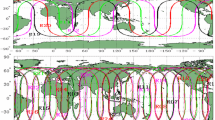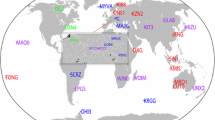Abstract
The heavy reliance of real-time precise point positioning (RTPPP) on external satellite clock products may lead to discontinuity or even failure in time-critical applications. We present an alternative approach of real-time undifferenced precise positioning (RUP) that, by combining satellite clock estimation and precise point positioning based on the extended Kalman filter, is independent of external satellite clock corrections. The approach is evaluated in simulated real time with the assistance of a variable number of IGS multi-GNSS stations located between 1359.7 and 4852.5 km from the users. The results show that even with a single auxiliary IGS station, RUP is still feasible and able to retain centimeter-level positioning accuracy. Typically, with three auxiliary IGS stations about 2000–3000 km away, an accuracy of about 2 cm in the horizontal and 5 cm in the vertical can be achieved. The performance of RUP is comparable to that of PPP using 5-s satellite clock products and notably exhibits superior short-term precision in dealing with high-rate (1 Hz) GPS/GLONASS observations. The addition of GLONASS observations reduces the convergence time by 56.9% and improves the 3-D position accuracy by 31.8% while increasing the processing latency by a factor of about 1.6. Employing three IGS stations over 2400 km away from the epicenter, RUP is applied for the rapid determination of coseismic displacements and waveforms for the 2016 Kaikoura earthquake, yielding highly consistent results compared to those obtained from post-processed PPP in the global reference frame. We also explore its potential in facilitating real-time online services in terms of real-time precise positioning, zenith tropospheric delay retrieving, and satellite clock estimation.



















Similar content being viewed by others
References
Bar-Sever Y, Blewitt G, Gross RS, Hammond WC, Hsu V, Hudnut KW, Khachikyan R, Kreemer CW, Meyer R, Plag H, Simons M (2009) A GPS real time earthquake and Tsunami (GREAT) alert system. EOS Trans AGU 90(52):2566
BD Standard (2015) Performance requirements and test methods for BDS RDSS unit. (BD420007–2015)
Boomkamp H (2010) Global GPS reference frame solutions of unlimited size. Adv Space Res 46(2):136–143
Cai C, Gao Y (2013) Modeling and assessment of combined GPS/GLONASS precise point positioning. GPS Solut 17(2):223–236
Chen L, Song W, Yi W, Shi C, Lou Y, Guo H (2017) Research on a method of real-time combination of precise GPS clock corrections. GPS Solut 21(1):187–195
Collins P, Lahaye F, Bisnath S (2012) External ionospheric constraints for improved PPP-AR initialisation and a generalised local augmentation concept. Proc. ION GNSS 2012, Nashville, Tennessee, USA, September 17–21, pp 3055–3065
Dai L, Chen Y, Lie A, Zeitzew M, Zhang Y (2016) StarFire SF3: worldwide centimeter-accurate real time GNSS positioning. In: Proceedings of ION GNSS 2016, Portland, Oregon, USA, September 12–16
Dousa J, Vaclavovic P (2014) Real-time zenith tropospheric delays in support of numerical weather prediction applications. Adv Space Res 53(9):1347–1358
El-Mowafy A, Deo M, Kubo N (2017) Maintaining real-time precise point positioning during outages of orbit and clock corrections. GPS Solut 21(3):937–947
Elsobeiey M, Al-Harbi S (2016) Performance of real-time precise point positioning using IGS real-time service. GPS Solut 20(3):565–571
Feng Y (2008) GNSS three carrier ambiguity resolution using ionosphere-reduced virtual signals. J Geodesy 82(12):847–862
Ge M, Chen J, Douša J, Gendt G, Wickert J (2012) A computationally efficient approach for estimating high-rate satellite clock corrections in realtime. GPS Solut 16(1):9–17
Geng J, Teferle FN, Meng X, Dodson AH (2011) Towards PPP-RTK: ambiguity resolution in real-time precise point positioning. Adv Space Res 47(10):1664–1673
Grejner-Brzezinska D, Kashani I, Wielgosz P, Smith D, Spencer P, Robertson D, Mader G (2007) Efficiency and reliability of ambiguity resolution in network-based real-time kinematic GPS. J Surv Eng 133(2):56–65
Hadas T, Bosy J (2015) IGS RTS precise orbits and clocks verification and quality degradation over time. GPS Solut 19(1):93–105
Hauschild A (2010) Precise GNSS clock-estimation for real-time navigation and precise point positioning. Dissertation, Technical University of Munich, Germany
Hauschild A, Montenbruck O (2009) Kalman-filter-based GPS clock estimation for near real-time positioning. GPS Solut 13(3):173–182
Kazmierski K, Sośnica K, Hadas T (2018) Quality assessment of multi-GNSS orbits and clocks for real-time precise point positioning. GPS Solut 22(1):11
Kouba J, Héroux P (2001) Precise point positioning using IGS orbit and clock products. GPS Solut 5(2):12–28
Leandro R et al. (2011) RTX positioning: the next generation of cm-accurate real-time GNSS positioning. In: Proceedings of ION GNSS 2011, Institute of Navigation, Portland, Oregon, USA, September 19–23, pp 1460–1475
Leick A, Rapoport L, Tatarnikov D (2015) GPS satellite surveying, 4th edn. Wiley, Hoboken
Li B, Feng Y, Shen Y, Wang C (2010) Geometry-specified troposphere decorrelation for subcentimeter real-time kinematic solutions over long baselines. J Geophys Res 115(B11):B11404
Li B, Li Z, Zhang Z, Tan Y (2017) ERTK: extra-wide-lane RTK of triple-frequency GNSS signals. J Geodesy 91(9):1031–1047
Li B, Zhang Z, Zang N, Wang S (2019) High-precision GNSS ocean positioning with BeiDou short-message communication. J Geodesy 93(2):125–139
Li L, Lu Z, Fan L, Li J (2015) Research on the architecture of Cloud GNSS based on Hadoop. In: Proceedings of China satellite navigation conference (CSNC) 2015, Xian, China, May 13–15, pp 717– 728
Li X, Zhang X, Ge M (2011) Regional reference network augmented precise point positioning for instantaneous ambiguity resolution. J Geodesy 85(3):151–158
Malys S, Jensen PA (1990) Geodetic point positioning with GPS carrier beat phase data from the CASA UNO experiment. Geophys Res Lett 17(5):651–654
Meindl M, Dach R, Jean Y (2012) International GNSS service technical report 2011. Astronom Institute Univ of Bern, Switzerland
Melgard T, Vigen E, Jong KD, Lapucha D, Visser H, Oerpen O (2009) G2-the first real-time GPS and GLONASS precise orbit and clock service. In: Proceedings of ION GNSS 2009, Institute of Navigation, Savannah, Georgia, USA, September 22–25, pp 1885–1891
Mervart L, Lukes Z, Rocken C, Iwabuchi T (2008) Precise point positioning with ambiguity resolution in real-time. In: Proceedings of ION GNSS 2008, Institute of Navigation, Savannah, Georgia, USA, September 16–19, pp 397–405
Nie Z, Gao Y, Wang Z, Ji S, Yang H (2018) An approach to GPS clock prediction for real-time PPP during outages of RTS stream. GPS Solut 22(1):14
Shi C, Yi W, Song W, Lou Y, Yao Y, Zhang R (2013) GLONASS pseudorange inter-channel biases and their effects on combined GPS/GLONASS precise point positioning. GPS Solut 17(4):439–451
Shi J, Yuan X, Cai Y, Wang G (2017) GPS real-time precise point positioning for aerial triangulation. GPS Solut 21(2):405–414
Song W, Yi W, Lou Y, Shi C, Yao Y, Liu Y, Mao Y, Xiang Y (2014) Impact of GLONASS pseudorange inter-channel errors on satellite clock corrections. GPS Solut 18(3):323–333
Takasu T, Yasuda A (2010) Kalman-filter-based integer ambiguity resolution strategy for long-baseline RTK with ionosphere and troposphere estimation. In: Proceedings of ION GNSS 2010, Institute of Navigation, Portland, Oregon, USA, September 21–24, pp 161–171
Teunissen P, Khodabandeh A (2015) Review and principles of PPP-RTK methods. J Geodesy 89(3):217–240
Yamada H, Takasu T, Kubo N, Yasuda A (2010) Evaluation and calibration of receiver inter-channel biases for RTK-GPS/GLONASS. In: Proceedings of ION GNSS 2010, Institute of Navigation, Portland, Oregon, USA, September 21–24, pp 1580–1587
Yang F, Zhao L, Li L, Feng S, Cheng J (2019) Performance evaluation of kinematic BDS/GNSS real-time precise point positioning for maritime positioning. J Navig 72(1):34–52
Weber G, Mervart L, Stürze A, Rülke A, Stöcker D (2016) BKG Ntrip client (BNC) version 2.12. Federal Agency for Cartography and Geodesy (BKG), Frankfurt, Germany
Wielgosz P, Kashani I, Grejner-Brzezinska D (2005) Analysis of long-range network RTK during severe ionospheric storm. J Geodesy 79(9):524–531
Wright TJ, Houlié N, Hildyard M, Iwabuchi T (2012) Realtime, reliable magnitudes for large earthquakes from 1 Hz GPS precise point positioning: the 2011 Tohoku-Oki (Japan) earthquake. Geophys Res Lett 39(12):L12302
Wübbena G, Schmitz M, Bagg A (2005) PPP-RTK: precise point positioning using state-space representation in RTK networks. In: Proceedings of ION GNSS 2005, Institute of Navigation, Long Beach, California, USA, September 13–16, 2584–2594
Zhang L, Yang H, Gao Y, Yao Y, Xu C (2018) Evaluation and analysis of real-time precise orbits and clocks products from different IGS analysis centers. Adv Space Res 61(12):2942–2954
Zhang X, Li X, Guo F (2011) Satellite clock estimation at 1 Hz for realtime kinematic PPP applications. GPS Solut 15(4):315–324
Zumberge JF, Heflin MB, Jefferson DC, Watkins MM, Webb FH (1997) Precise point positioning for the efficient and robust analysis of GPS data from large networks. J Geophys Res 102(B3):5005–5017
Acknowledgements
IGS and its analysis centers are acknowledged for their contributions in promoting the multi-GNSS network worldwide and for providing multi-GNSS data and products used in this study. We would like to thank Elisabetta D’Anastasio (GNS Science, New Zealand) for providing the GNSS data of the 2016 Kaikoura earthquake. This work is supported by the National Natural Science Foundation of China (Grant No. 41604018) and the Fundamental Research Funds for the Central Universities of China (Grant No. 2019B17514).
Author information
Authors and Affiliations
Corresponding author
Additional information
Publisher's Note
Springer Nature remains neutral with regard to jurisdictional claims in published maps and institutional affiliations.
Rights and permissions
About this article
Cite this article
Liu, Z., Yue, D., Huang, Z. et al. Performance of real-time undifferenced precise positioning assisted by remote IGS multi-GNSS stations. GPS Solut 24, 58 (2020). https://doi.org/10.1007/s10291-020-0972-6
Received:
Accepted:
Published:
DOI: https://doi.org/10.1007/s10291-020-0972-6




